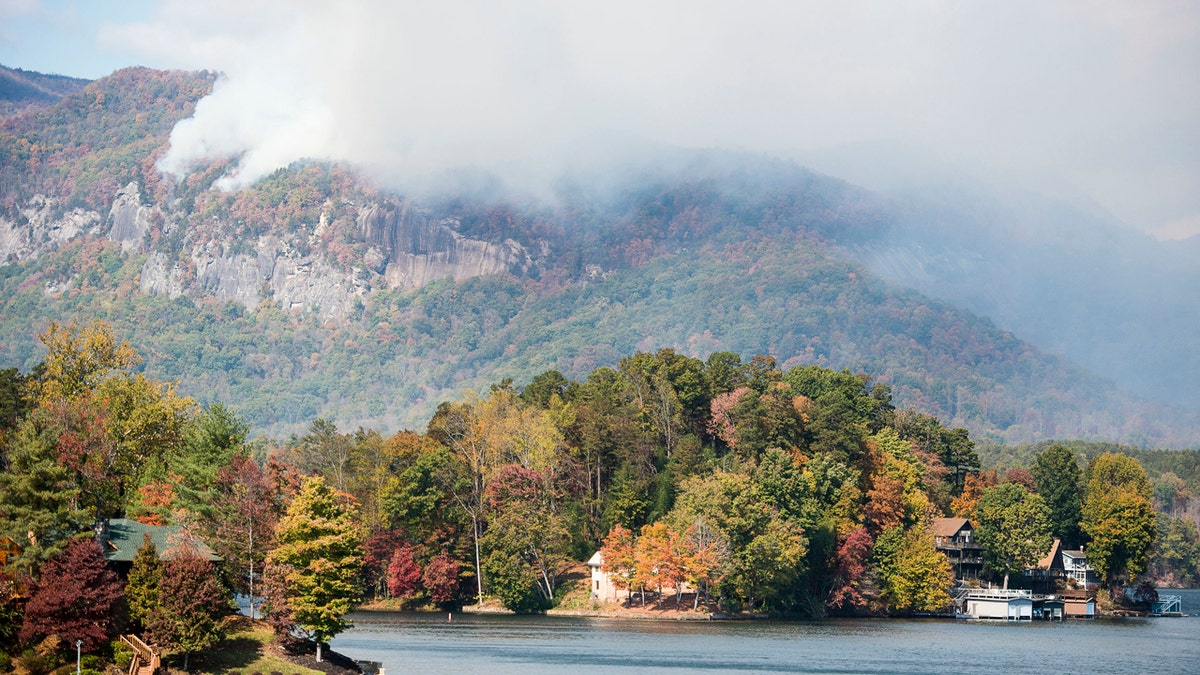
Smoke from the Party Rock fire near Lake Lure spreads as emergency services and the N.C. Forest Service work to contain the blaze Wednesday Nov. 9, 2016 at Lake Lure, N.C. (Abigail Margulis/The Asheville Citizen-Times via AP)
ATLANTA – Unseasonably warm dry weather has deepened a drought that's igniting forest fires across the southeastern U.S., forcing people to flee homes in the Appalachian Mountains and blanketing Atlanta in a smoky haze.
Thursday's national drought report shows 41.6 million people in parts of 15 southern states living in drought conditions. The worst drought is in Georgia, Alabama, Mississippi and Tennessee, but extreme drought also is spreading into the western Carolinas, and Kentucky and Tennessee had the most fires.
All but two of the 61 active large wildfires nationwide Thursday were in the Southeast, according to the U.S. Forest Service. Nearly a dozen large fires were uncontained, with 14 more breaking out Thursday alone.
"Right now we're kind of holding our own," said Jennifer Turner, a spokeswoman for the Kentucky's state Division of Forestry. "We've been able to get control over some of the smaller fires."
Nearly 390 firefighters and support crews and half a dozen water-dumping helicopters were battling 20 fires in Kentucky Thursday that together have burned nearly 20,000 acres, Turner said.
Humidity is so low in the normally lush Appalachians that forestry officials are bracing for more.
North Carolina's Gov. Pat McCrory declared a state of emergency for a fourth of his state's 100 counties, to help with evacuations and provide more assets to fight the fires.
Authorities also made two arson arrests in eastern Kentucky, and citied another man for causing a brush fire while defying a burn ban. Tennessee authorities also reported arrests for arson and burning violations.
Fires near the southern end of the Appalachian Trail this week have sent smoky haze blowing southward over Atlanta.
Bans on outdoor burning were in effect across the drought zone, and in Alabama, authorities extended that ban throughout the state, where drought is choking 80 percent of the land, drying up streams and lakes and killing plants. Firefighters were battling three active wildfires in Alabama on Thursday, the latest of more than 1,100 fires that have charred nearly 12,000 acres in the last month.
Tuscaloosa and Birmingham have both tied or broken records for days without measurable rain; neither has had more than sprinkles since late September. And Noccalula Falls, a popular attraction on Lookout Mountain in northeast Alabama, has been bone dry for weeks.
"It's fed by Black Creek and the creek is dry. There's not even a trickle going over the falls," Kaila Fair, manager at the adjoining campground, said Thursday.
In mountainous western North Carolina, people living on five roads near one roaring blaze were advised to leave their homes, and residents of 38 more homes in another part of the state were told to evacuate ahead of a separate wildfire.
One of the South's largest blazes, in the Cohutta Wilderness area just south of the Georgia-Tennessee line, has grown rapidly in the past 24 hours with high winds spreading the flames. Nearly 300 people are battling that fire, which has consumed 10,000 acres of forest, the U.S. Forest Service said.
And in the hills outside Chattanooga, firefighters were trying to save homes on both Signal Mountain and Mowbray Mountain. They may get reinforcements: The Federal Emergency Management Agency announced its reimbursement of most of the costs for one of the fires, after a request from Tennessee.
Dai Harris, 29, was staying in a local firehouse after being evacuated from his home near Mowbray Mountain, where a fire that seemed under control earlier in the day spiked back up.
"I'm getting very concerned, mainly for my neighbors," Harris said. "I'm concerned about their houses now. I'm afraid they're not going to come home to one."
"I know that there's a lot of smoke, and it's covering a broad area, so I assume there's still quite a bit of flames out there," Harris added.
Drought conditions also are persisting in parts of the Florida panhandle and portions of Virginia, Louisiana, Mississippi, Texas, Oklahoma, Arkansas, Indiana and Missouri, according to the Drought Monitor from the National Drought Mitigation Center at the University of Nebraska-Lincoln.

